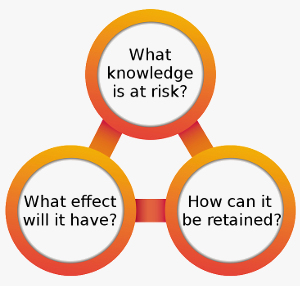Knowledge retention involves capturing knowledge in the organization so that it can be used later. In a previous section on organizational memory, Walsh and Ungson (1991) defined five knowledge repositories, namely individuals, culture, transformations (i.e. procedures & formalized systems), structures (e.g. formal and informal networks), and external activities. This is where knowledge can exist or be retained in an organization. In this section, we are interested in the managerial side, so as to answer the question: How can management promote the retention of (crucial) knowledge?
Most often, one hears of knowledge retention in the context of losing key employees and using techniques such as exit interviews to try to capture their knowledge. In reality, knowledge retention should be integrated into how the organization operates and start well before a key employee is about to depart. Although it is considered crucial for long term organizational success, few organizations have formal knowledge retention strategies (Liebowitz 2011).

A knowledge retention strategy as a part of knowledge management (KM) will identify the knowledge resources that are at risk and must be retained, and then implement specific initiatives so as to keep these resources in the firm. Like most other KM-related processes and strategies, success depends upon successful knowledge sharing and having a knowledge sharing & learning organizational culture.
Apart from the more general knowledge sharing initiatives that a firm may use - e.g. support of formal & informal knowledge networks (social areas, social media, meetings, company functions, knowledge fairs, expertise locator, etc.), changing the organization culture, etc. - examples of tools & techniques which can be used specifically for knowledge retention include (adapted from Smith 2007, Liebowitz 2009, and Liebowitz 2011):
- Implementing reward structures to encourage sharing of key knowledge.
- Use of project teams and cross-functional project teams.
- After-action reviews.
- Storytelling.
- Mentoring programs & job shadowing.
- Interviews & exit interviews.
- Job rotation.
- Company procedures/processes manuals.
- Taking advantage of the knowledge of retirees.
Knowledge Retention Strategy
Doan et al (2011) identify three basic questions that must be asked when considering knowledge retention:
- What knowledge may be lost?
- What are the organizational consequences of losing that knowledge?
- What actions can be taken to retain that knowledge?
Expanding upon these questions, one can outline several concrete steps necessary in the formulation of a knowledge retention strategy:
Step 1: Understand your risk factor: Liebowitz (2011) identified the following risks:
- The average age of your employees is high
- The company has placed insufficient focus on:
- knowledge capture
- mentoring program
- employee training and development
- Information is difficult to find or is often misplaced.
- There is little informal communication in the organization.
- Many knowledgeable employees are leaving the organization.
Step 2: Understand which knowledge is critical and focus on this (Corney 2018) (read more about this under Knowledge Organization & Assessment)
Step 3: Formulate a strategy using the pillars of knowledge retention (Liebowitz 2009 & 2011): Knowledge retention consists of a wide range of tools, some easy and some hard to implement. Liebowitz identifies four categories which encompass all the initiatives within knowledge retention. These are:
- Recognition and reward structure: Management has the choice to use either intrinsic motivators (i.e. which make the job itself more satisfying, such as praise or recognition) or extrinsic motivators (i.e. which offer benefits unrelated to the job, such as money) (Gamelgaard 2007). These must take organizational as well as national cultural factors into account (Gamelgaard 2007), but overall the most effective and longer lasting appear to be intrinsic motivators (Gamelgaard 2007 & Liebowitz 2009). However, a combination of both is usually the way to go.
- Bidirectional knowledge flow: Establishing a two-way system of knowledge capture, where knowledge is not only passed down from the senior employee to the junior employee, but also vice versa.
- Personalization and codification: Personalization refers to connecting people and includes tools such as mentoring, jon rotation, knowledge fairs, communities, and so on, while codification includes tools like after action reviews, various knowledge repositories, lessons learned systems, etc. (Liebowitz 2009).
- The golden gem: Bringing back important retirees in various capacities. This includes rehire programs, consultancy, part-time work, temporary jobs, etc. (Corporate Executive Board 2005). Using a phased retirement system (e.g. leave of absence – part time work – casual rehire) can also help to slowly lose a key employee and to gradually transfer all his key knowledge to the organization (Corporate Executive Board 2005).
Success Factors and DOs and DON'Ts of KR
Doan et al (2011), following a comprehensive review of knowledge retention literature, arrive at the following key success factors:
- Top management support
- Knowledge retention strategy
- Learning culture
- Human resource practices (since knowledge resides in people, knowledge retention is closely linked to HR practices including recruitment, education, rewards, and performance management)
- Information and communication technology tools
Similarly, Corney (2018) outlines some basic DOs and DON'Ts of knowledge retention:
- Do not capture "just in case". This leads to repositories of unused information.
- Make sure that you are focusing on capturing Critical Knowledge, i.e. knowledge that the organization would struggle without.
- When departures occur, offer them the chance to "leave a legacy" in an alumni network.
- Make sure that knowledge retention and capture is the "way we do things around here" and that it is part of any work process and at all stages of the employment cycle.
